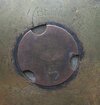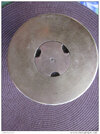In my intro I did say I wasn't much of a collector of ordnance...then I looked around the office and realised there was 5.56, 9mm, .50 cal, 20mm, 76mm and 4.5in cases and cartridges lying around. Funny how it creeps up on you?
Anyway, in the 'collection' is a German First World War shell case I picked up at an antique shop last year. It has clearly been polished for best part of 100 years and the stamps on the base are fading. Normally I would pass this by, but something caught my eye - the primer had something that looked very much like arabic script or writing on it. I believe the Ottoman Empire used arabic at this time, so was it Turkish?
Its a Patronenfabrik shell from Karlsruhe dated 1916. I have showed the script to an Egyptian friend who confirmed it was arabic but had no idea what it meant and passed it on to a friend of his who was studying Turkish and Ottoman literature. Their conclusion was it meant nothing in Persian, Turkish or Arabic.
So, has anyone ever seen such a script on a shell case? And is there any idea what it means?



Anyway, in the 'collection' is a German First World War shell case I picked up at an antique shop last year. It has clearly been polished for best part of 100 years and the stamps on the base are fading. Normally I would pass this by, but something caught my eye - the primer had something that looked very much like arabic script or writing on it. I believe the Ottoman Empire used arabic at this time, so was it Turkish?
Its a Patronenfabrik shell from Karlsruhe dated 1916. I have showed the script to an Egyptian friend who confirmed it was arabic but had no idea what it meant and passed it on to a friend of his who was studying Turkish and Ottoman literature. Their conclusion was it meant nothing in Persian, Turkish or Arabic.
So, has anyone ever seen such a script on a shell case? And is there any idea what it means?


Last edited:


